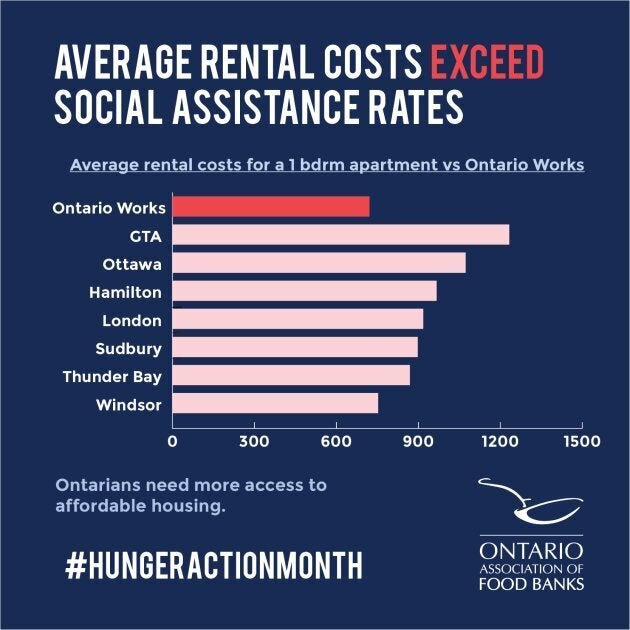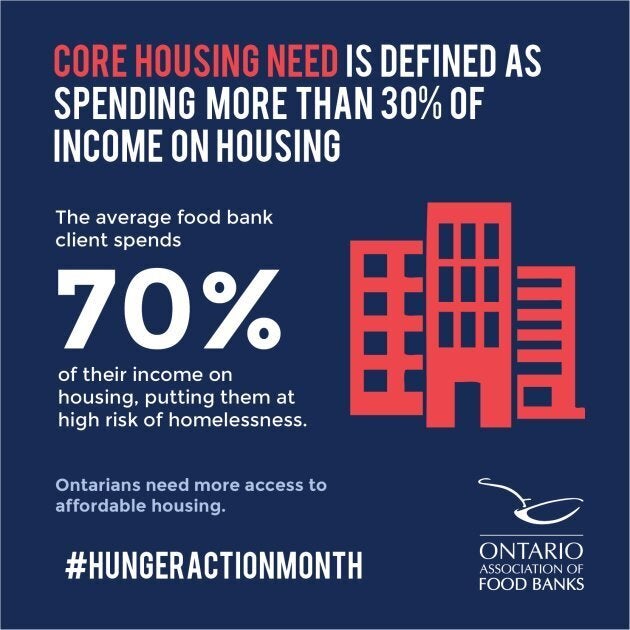It is difficult to have a discussion about addressing poverty without talking about the issue of affordable housing. Access to adequate, affordable housing is essential to building a stable life free from poverty.
Whether or not someone has access to affordable housing can have a direct impact on their health, ability to acquire and hold employment, and even their interactions with the justice system. For families, it can impact a child's growth and development, affect educational outcomes, as well as make it difficult to afford all other necessities, like heat and hydro, food, personal care items, and transportation.

Despite its importance, finding an affordable place to live is becoming increasingly more difficult for Ontarians. Between 2012 and 2016, the average Ontario housing price grew 18 per cent, and the average rent for a two-bedroom apartment increased 12 per cent.
The ability to afford that housing did not go up as quickly: between 2011 and 2015, the median income in Ontario only grew by 7.5 per cent. As market-rate housing became increasingly less affordable, the wait list for rent-geared-to-income (RGI) housing (units where rent is set to an affordable percentage of household income) grew: 171,360 households were on the wait list in 2015, up nine per cent since 2011.
There are many theories behind the surge in housing prices, with the two major culprits being a lack of supply (due to land use regulations, such as out-of-date zoning restrictions that don't allow for density, excessive red tape that increases costs for developers, and a shortage of suitable infrastructure), and a surge in demand (from foreign buyers, speculative investments and low interest rates).
As housing prices increase, it has spillover effects into the cost of rent as people priced out of purchasing a home turn to renting. Yet construction on purpose-built rentals such as apartment buildings (as opposed to condos or houses rented out by the owner) was stalled for four decades. While there has been a recent resurgence in purpose-built rentals, it will take a long time to catch up with demand. This is especially concerning for low-income households, as two-thirds of them rent their homes.

The last stop on the housing continuum before getting into shelters and supportive housing is rent-geared-to-income units (otherwise known as social housing), but there is simply not enough to meet demand. Between the mid '60s and early '90s, the federal and provincial government built over 200,000 social housing units in Ontario. However, by 1996, both governments had stopped any funding for new social housing, and nothing new was built until 2000.
Since then, most of the responsibility for administering, building and maintaining social housing has been downloaded onto municipal governments, who have far less ability to raise money through taxation. While the provincial and federal government have provided some funding to municipal agencies through the Investment in Affordable Housing (IAH) program, it is not nearly enough.
The IAH will only fund the creation and repair of 11,000 social housing units between 2014 and 2020, but it's estimated that we would need to build 10,000 more units each year to keep up with demand. Municipal agencies like the Toronto Community Housing Corporation (TCHC) are in dire straits, estimating that by 2023, three-quarters of their existing stock will be in poor or critical condition, and 7,500 homes will have to simply be shut down. The impact that this will have on the people sitting on Toronto's 10-year-long wait list will be profound.
The Canada Mortgage and Housing Corporation (CMHC) defines "Core Housing Need" as either spending more than 30 per cent of income on housing, or living in housing that is not in good repair or too small, with 13 per cent of Ontarians falling under this umbrella. At current rates, it would take 73 years to eliminate core housing need in Ontario.
These trends are of incredible concern to food banks in Ontario. With 90 per cent of food bank clients living in either rental or social housing, these housing shortages and rental spikes have a huge impact on them. The average food bank client spends 70 per cent of their income on housing, which puts them at high risk of homelessness. According to our research, after paying for housing and utilities, 45 per cent of food bank clients only have $100 left over, leaving little else for essentials like food, transportation and medicine.

The primary source of income for two-thirds of food bank clients is either Ontario Works (OW) or the Ontario Disability Support Program (ODSP). The high cost of housing means that the meager amount they receive must be stretched even further. The total amount that a single person on OW receives — $721 a month — is less than the average cost of a one-bedroom apartment in most major Ontario cities.
With statistics like these, it is in many ways unsurprising that so many more people need to use food banks. In our 2016 Hunger Report, we found that food bank use in Ontario has increased by 6.9 per cent since 2008. In Toronto, where the cost of housing is one of the highest in the country, the Daily Bread Food Bank saw a 24-per-cent increase from 2008-2017, as detailed in their latest Who's Hungry report.
Housing is the biggest expense for most people, and is a non-negotiable cost. You have to pay your landlord the full cost of your rent each month, lest you risk eviction and potentially find yourself on the street. To be able to afford rent, people often cut back on other essentials, such as food, heat, or hydro. Fortunately, food banks are there to help.

This is why the Ontario Association of Food Banks supports a portable housing benefit. This benefit would be paid out directly to the tenant, and ensure that their rent does not exceed 30 per cent of their income. It would be targeted to those on social assistance and the working poor who cannot afford their rent.
A portable housing benefit allows people to stay in their homes instead of requiring them to move to a new unit, stabilizing existing communities. Most households experience core housing need for less than two years. This portable housing benefit would allow greater choice and flexibility, while decreasing the need to build social housing.
We are cautiously optimistic about the chances of such a program being implemented. Currently, the provincial government is piloting a portable housing benefit for survivors of domestic violence, and is planning on engaging in consultations around a framework for a portable housing benefit.
There is also a proposal submitted by the National Housing Collective — which includes our member, the Daily Bread Food Bank — to include a single, harmonized, co-funded federal-provincial-territorial portable housing benefit for all eligible Canadians in the upcoming National Housing Strategy.
We are seeing the trend in food bank usage go the wrong way — up, instead of down. If we, as a society, want to be serious about reducing hunger and poverty, we have to address our affordable housing crisis, the biggest stressor on the budgets of low-income Ontarians. With a provincial and federal government that have both stated their commitment to reducing poverty, we are in a great moment to introduce a housing benefit that makes a difference in the lives of families who are struggling to make ends meet each month.
If you support a portable housing benefit, contact your MPP or MP and let them know! Tweet about the need for a portable housing benefit using the hashtag #LetsTalkHousing. For more information on how you can take action on hunger, please visit www.oafb.ca/hunger-action-month
Also on HuffPost: